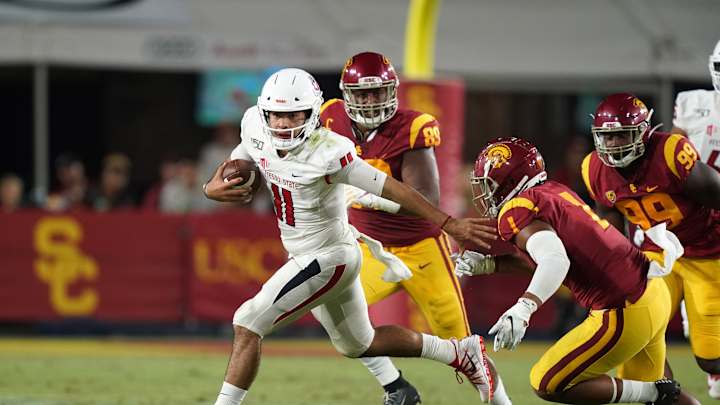What We Learned: USC defense has 'work to be done' ahead of 'master offensive mind' David Shaw, Stanford

Clancy Pendergast rattled off the numbers without hesitation. He almost sounded indignant.
“The quarterback had 56 on scrambles, he had 44 on the zone read with 13 being the longest, they had 27 yards on a reverse, and they had anywhere from 20-30 on fly sweeps," the USC defensive coordinator said following Wednesday's practice. "The running back only ran for 53 yards.”
Pendergast’s math is spot on. The problem is it all counted, and it amounted to more than 200 rushing yards for Fresno State this past Saturday. Yet he was adamant USC fit the run well.
“The biggest stat that I have that I’m concerned about in the running game was, what’s the true running back carrying the football? That’s the guy we’re trying to stop. The guy that’s going to get the ball from the quarterback’s hands on an in-between-the-tackle basis.”
That guy will be Cameron Scarlett this weekend, and the Trojans might see a lot of him given QB K.J. Costello’s uncertain availability after suffering a concussion in Week 1. Scarlett ran 22 times for 97 yards in the Cardinal’s victory against Northwestern.
Stanford, of course, has typically been run-heavy against USC, and over the past decade has had its way on the ground. Even last year, when the Cardinal ranked 123rd nationally in rushing offense, Bryce Love managed a season-high 136 yards against the Trojans.
It was his only 100-yard game of the season.
When asked to choose whether he'd prefer to have a dominant pass rush or run defense this weekend, defensive line coach Chad Kauha’aha’a didn’t flinch.
“Always stopping the run," he said. "I’m the D-line coach, so always stopping the run is the No. 1 goal. We all know Stanford prides itself on the run game. People can say what they want about the Stanford O-line being fresh, new. That’s David Shaw. Coach Shaw is a master offensive mind. Whatever situation they’re in, he’ll have them ready.”
Coach K echoed Pendergast in that he felt the guys up front controlled their gaps and sprinted to the ball. According to the staff, the bigger issues lie with how the linebackers and defensive backs tackled, especially on the perimeter. Pendergast said Palaie Gaoteote, who still finished with eight tackles, was “overzealous” and still getting comfortable in only his second start at weakside linebacker.
“I think it’s just repetition,” Pendergast said of EA. “He’s got to get out there and get a feel for the game and get loosened up and get a feel for the offensive line and the speed of the back. He’s a really quick key-and-diagnose guy. So I think backing him up a little bit, backing him up off the ball … might help him a little bit.”
Pendergast noted because there was little film on Fresno State QB Jorge Reyna, he and the defense were “adjusting on the fly.” Reyna, who rushed for 88 yards after accounting for three sacks, surprised USC with his scrambling and ability to keep plays alive. Pendergast was already concerned about his defensive front being consistent with its rushing lanes. That ultimately cost USC as well.
“That’s the hardest thing I think for a defensive lineman … is keeping the quarterback in your sights as you do rush,” Pendergast said. “Take the blinders off, press the pocket, see him step up and then come off blocks and then try to get a sack instead of focusing on just beating your 1-on-1 matchup.
“We could have gotten at least five more sacks.”
A few of those involved freshman Drake Jackson, who still had a monster debut with 1.5 tackles for loss, half a sack, two pass breakups and five pressures. Kauha’aha’a said he was both encouraged and frustrated.
“My man Drake, he was in the backfield the hole time but he couldn’t finish,” Kauha’aha’a said. “He gets so anxious and he’s trying so hard that he slips by. …
“You don’t want to know what I told him on the sideline.”
Sacking the quarterback is obviously not something easily simulated in practice, but the conversation has been prevalent from the moment Saturday night’s game concluded. The Trojans have continued to drill it in practice, and the hope is their rushers will sharpen their finishing skills the more they play.
It’s otherwise been a big study period for USC as it prepares for Stanford’s pro style offense, which is out of a litany of formations. Complicating matters is that there’s again little film on the possible starting QB. Davis Mills had attempted all of two passes before playing the second half last week. Neither Pendergast nor DBs coach Greg Burns would offer much of a scouting report on the redshirt sophomore.
“We spent a lot of time watching film,” Pendergast said with a sly grin, intimating he might have even looked at Mills’ high school tape. “It’s been a long week.”
Whether Mills or Costello plays, USC anticipates Stanford to work its young defensive backs downfield.
“They trust their receivers on 50-50 balls and we have to defend it,” said Burns, who graded his CBs at a C+ in Game 1 and the safeties a B-. “Their style of play is going to be more back shoulder, which requires a different technique versus the traditional long ball plays. So there’s a little bit of work to be done there.”
Stanford, a game that’s been played in September six years in a row now, is often USC’s litmus for how much.
